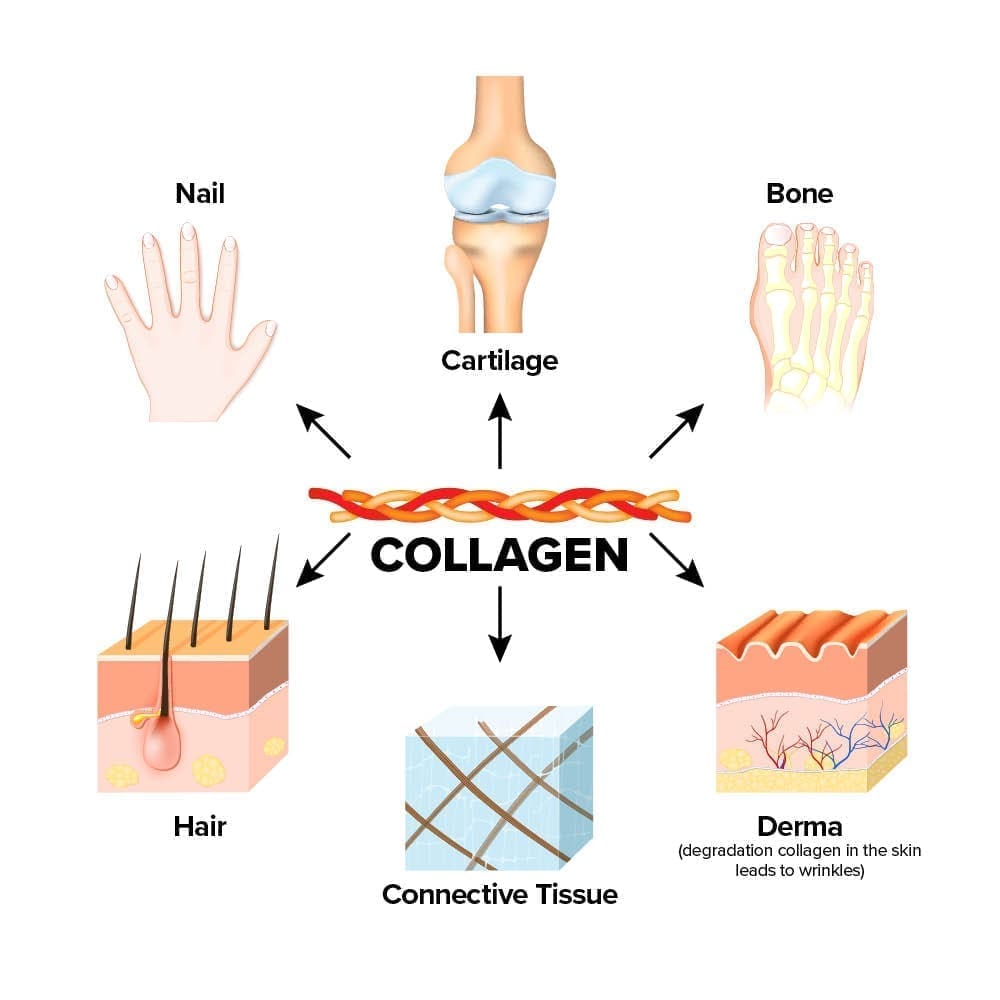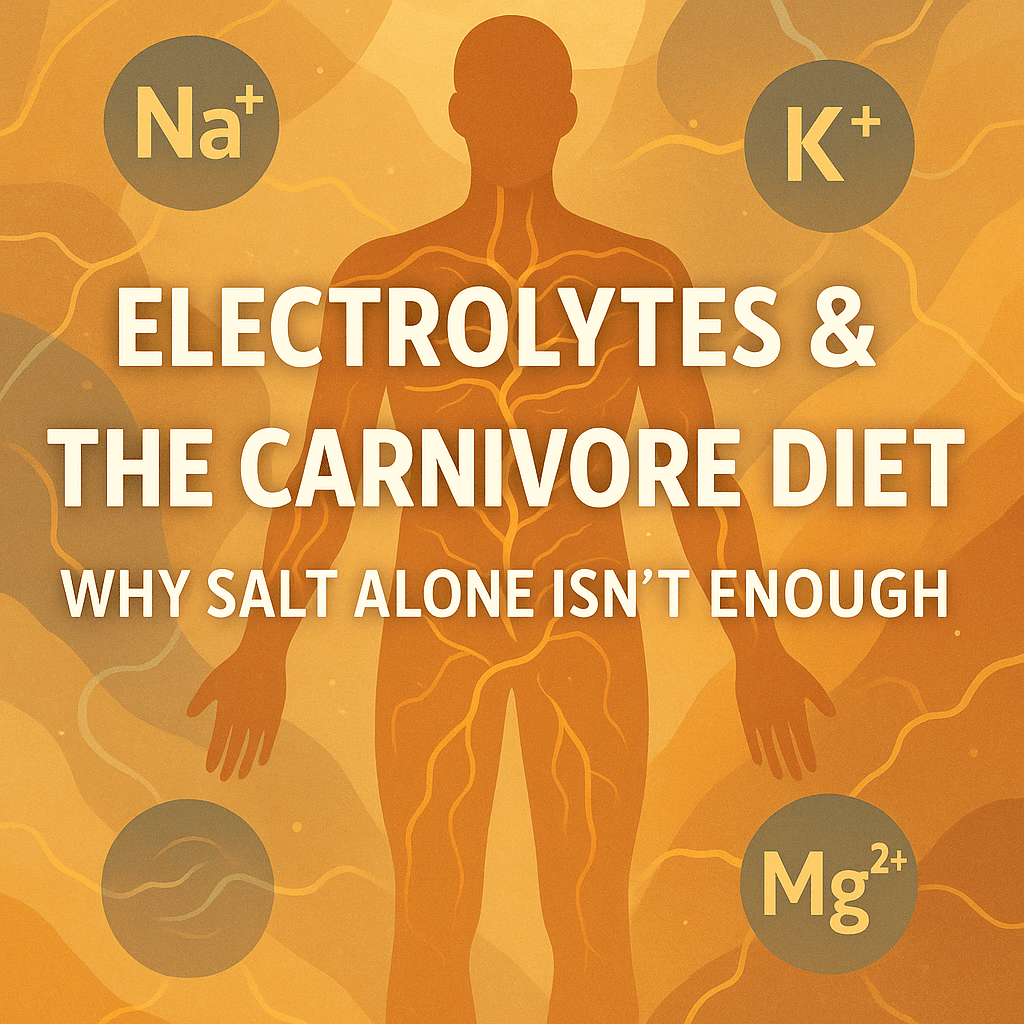If you’re following a carnivore or heavily meat-based diet, you’re probably getting more protein, iron, and B12 than most people — but are you getting enough magnesium?
It’s one of the most overlooked minerals in the ancestral health space, yet it plays a critical role in everything from muscle function to mood regulation. And on a meat-heavy diet, your magnesium intake might be much lower than you think.
Let’s break down why magnesium matters, how deficiency shows up, and how to supplement it wisely — especially on a low-carb or carnivore regimen.
Disclosure: This article contains affiliate links. As an Amazon Associate, I may earn a small commission from qualifying purchases—at no extra cost to you.
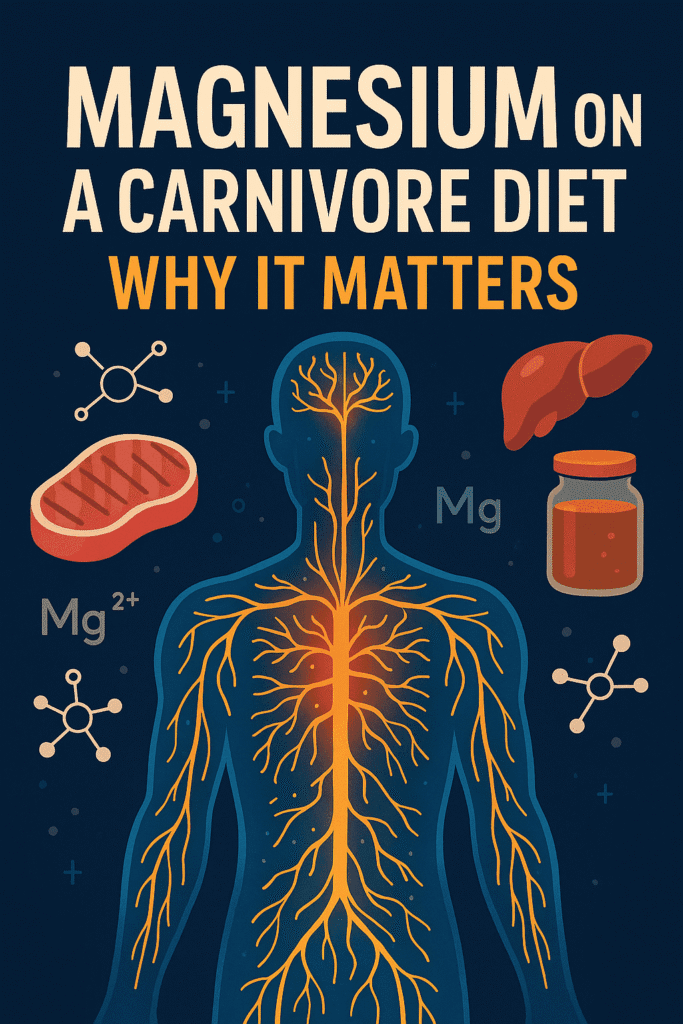
📚 Table of Contents
- What Magnesium Actually Does
- Why Carnivore Diets Are Often Low in Magnesium
- Signs of Magnesium Deficiency
- What Drains Magnesium? (Besides Just Not Eating It)
- What to Buy: Choosing the Right Magnesium Supplement
- How Much, When, and What to Expect
- How It Ties Into Electrolytes
- Build Your Own Carnivore Electrolyte Mix
- How Much Magnesium Is Actually in Animal Foods?
- FAQ
- Magnesium Podcast
- Final Thoughts
- External Resources & Studies on Magnesium and Carnivore Diets
🧠 What Magnesium Actually Does
Magnesium is a cofactor in over 300 enzymatic reactions in the body. In plain English: you need it for your body to do almost anything.
Key roles include:
- Supporting ATP (energy) production — it’s actually Mg-ATP that fuels your cells
- Balancing the nervous system — calms the brain, eases anxiety, supports GABA

- Preventing muscle cramps and twitching — helps muscles relax after contraction
- Maintaining heart rhythm and blood pressure
- Supporting insulin sensitivity and blood sugar control
- Aiding serotonin and melatonin production — essential for mood and sleep
- Regulating calcium and vitamin D — crucial for bone health
While meat is incredibly nutrient-dense, most cuts don’t offer much magnesium. Without organs, seafood, or bone broths, your levels can slide.
🥩 Why Carnivore Diets Are Often Low in Magnesium
A meat-heavy diet naturally limits some of the richest magnesium sources: leafy greens, nuts, seeds, cacao, and legumes. But that’s only part of the picture.
Other reasons magnesium runs low on carnivore:
- High phosphorus (from meat) can inhibit magnesium absorption
- Low insulin levels promote salt and water loss — magnesium follows
- Coffee and caffeine increase urinary magnesium loss
- Sweating, fasting, or stress all increase depletion
- Bone broth only provides good magnesium if it’s long-simmered (6–12+ hours)
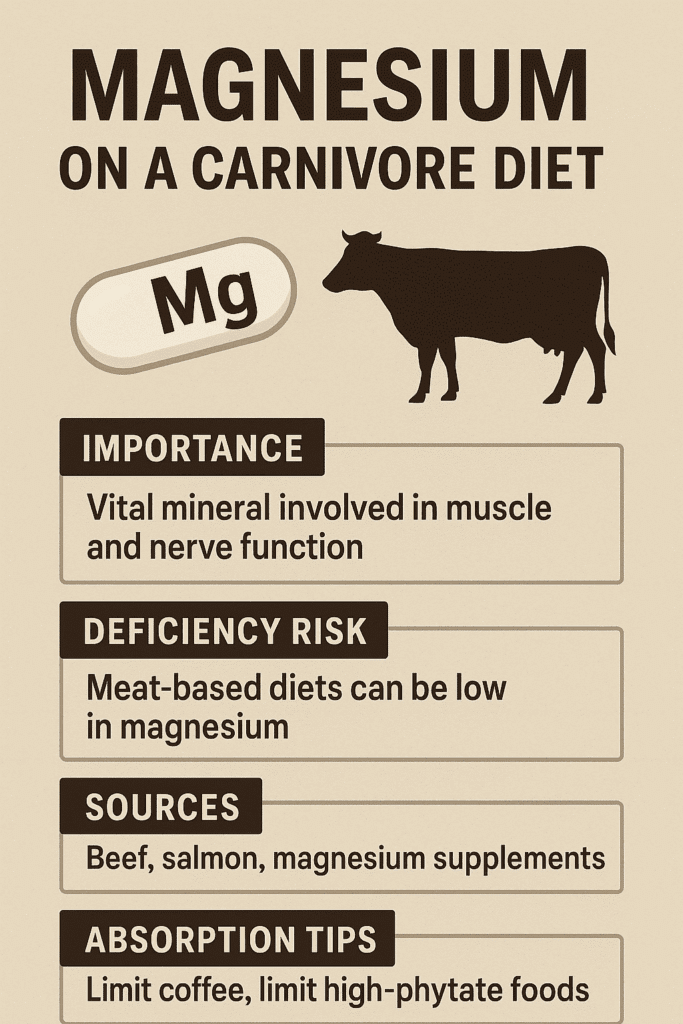
Even if you’re eating nose-to-tail, most carnivore diets fall short of the ~400 mg/day target — especially if you’re active, stressed, or drink coffee.
⚠️ Signs of Magnesium Deficiency
These often creep in subtly and are easy to misattribute to “adaptation” or electrolyte imbalance:
- Muscle cramps (especially in calves or feet)
- Eyelid twitching
- Fatigue or brain fog
- Anxiety or restlessness
- Poor sleep
- Heart palpitations
- Sensitivity to light, noise, or stress
- Constipation
- Low recovery from exercise
If you’re ticking a few of these boxes, magnesium may be the missing link.
☕ What Drains Magnesium? (Besides Just Not Eating It)
Some lifestyle and dietary choices can actively reduce your magnesium levels:
| Factor | Effect |
|---|---|
| Coffee / Caffeine | Increases urinary magnesium loss |
| Alcohol | Disrupts absorption and excretion |
| Stress (cortisol) | Triggers magnesium wasting |
| Heavy sweating | Flushes magnesium from the system |
| High meat intake (phosphorus) | Reduces magnesium absorption |
| Fasting or low-carb adaptation | Increases electrolyte loss through kidneys |
Most people do well with a combo of glycinate (evening) and malate (morning). Avoid magnesium oxide — it’s poorly absorbed and mostly acts as a laxative.
⏱ How Much, When, and What to Expect
- Start with 200 mg/day and build up slowly to 400 mg/day if needed
- Take glycinate or taurate at night for sleep support
- Use malate in the morning if you’re dealing with fatigue or muscle tension
- Split doses can reduce digestive upset
- Stop increasing if stools become too loose
Note: magnesium works best when paired with sodium and potassium — especially on carnivore.
🧂 How It Ties Into Electrolytes
Magnesium doesn’t work in isolation. On carnivore, electrolytes shift rapidly due to lower insulin and increased salt loss. Magnesium helps regulate:
- Electrical signals across muscles and nerves
- Sodium and potassium retention in the kidneys
- Heart rhythm and vascular tone
That’s why magnesium is often the missing piece when salt alone doesn’t fix cramps, fatigue, or “keto flu.”
🎯 Order Magnesium Supplements on Amazon
🇺🇸 Buy on Amazon US
🇬🇧 Buy on Amazon UK
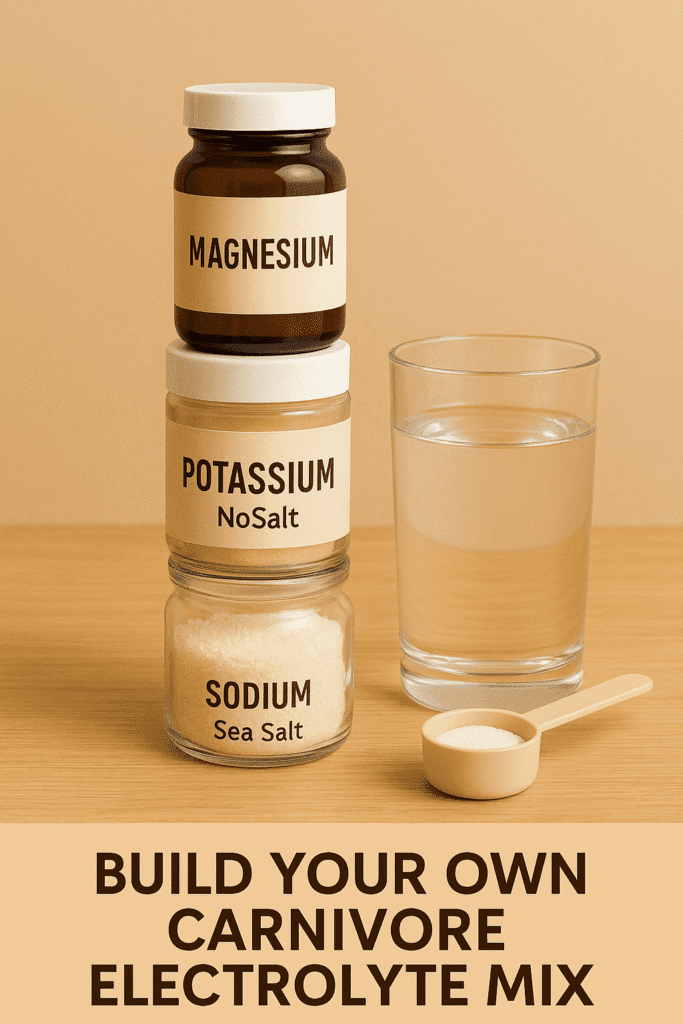
🧂 Build Your Own Carnivore Electrolyte Mix
Low-carb and carnivore diets naturally lower insulin levels, which causes the kidneys to excrete more sodium — and with it, potassium and magnesium. That’s why many people feel better once they restore these key electrolytes.
If you prefer DIY over commercial brands like LMNT or Re-Lyte, here’s how to make your own cost-effective, carnivore-friendly mix:
🧪 DIY Electrolyte Mix Formula
| Ingredient | Amount per Liter (approx.) | Function |
|---|---|---|
| 🧂 Sea Salt (Sodium Chloride) | 1–1.5 tsp | Replaces sodium lost via urine/sweat |
| 🥄 Potassium Chloride (e.g., NoSalt or Lite Salt) | 1/4–1/2 tsp | Balances sodium, supports muscle/nerve function |
| 🧬 Magnesium Malate or Glycinate Powder | 200–400 mg | Supports muscle relaxation, nerve signals, stress resilience |
| 💧 Water | ~1 liter | Hydration base — filtered or spring water preferred |
| 🍋 Optional: Squeeze of lemon or trace minerals | To taste | Helps absorption and adds flavor without sugar |
🛒 What to Buy: Choosing the Right Magnesium Supplement
Magnesium isn’t one-size-fits-all. Different forms (called “chelates” or “complexes”) have different effects in the body — some calm the mind, some boost energy, and some help with digestion. Here’s a breakdown to help you choose what works best for you.
🎯 Order from Amazon
🌍 Choose your region:

| Magnesium Form | Best For | Notes |
|---|---|---|
| 💤 Magnesium Glycinate | Sleep, anxiety, nervous system calm | Highly bioavailable. Gentle on the stomach. Great for nighttime use. |
| ⚡ Magnesium Malate | Energy, muscle pain, fatigue | Bound to malic acid (Krebs cycle). Good morning option. May feel stimulating. |
| ❤️ Magnesium Taurate | Heart health, blood pressure, emotional stress | Taurine synergizes with magnesium for cardiovascular and nervous system stability. |
| 💩 Magnesium Citrate | Occasional constipation | Helps draw water into the bowel. Can cause loose stools — not ideal for daily use. |
| 🧠 Magnesium L-Threonate | Cognitive support, brain fog, mood | Crosses the blood-brain barrier. Expensive, but effective for mental clarity. |
| 🧂 Magnesium Chloride (topical) | Muscle cramps, skin absorption | Can be used as magnesium oil or flakes in a bath. Bypasses digestion. |
🔍 Extra Notes on Magnesium for Carnivore Dieters
As this article has shown, magnesium plays a critical role in energy, mood, muscle function, and electrolyte balance — all especially relevant on a meat-based diet. Here are a few extra considerations to take your magnesium awareness to the next level:
🍖 How Much Magnesium Is Actually in Animal Foods?
While most people associate magnesium with leafy greens and seeds, some animal-based sources do offer modest amounts — though likely not enough on their own to meet daily needs. Here’s what the numbers show:
| Food | Magnesium (per 100g) |
|---|---|
| 🐟 Chinook Salmon | ~122 mg |
| 🐄 Beef Liver | ~14–25 mg |
| 🍖 Beef (steak cuts) | ~20–30 mg |
| 🍗 Chicken Thigh | ~20 mg |
| 🍲 Bone Broth (1 cup) | ~17 mg (higher with long simmer times) |
🎯 Magnesium Supplements Are available at Amazon
🌍 Choose your region:
🇺🇸 Buy on Amazon US
🇬🇧 Buy on Amazon UK
FAQ
Magnesium Podcast
In this episode, Ai-den and Ai-nita break down what magnesium does, why it’s often lacking in meat-heavy diets, and how to get your levels back on track.
Whether you’re fully carnivore, keto, or just low-carb curious, this episode is packed with insights to help you feel stronger, calmer, and more balanced.
🧾 Final Thoughts
Magnesium is easy to overlook on a carnivore diet — but once you dial it in, the difference can be dramatic. Better sleep. Fewer cramps. Calmer mind. Stronger recovery.
Whether you’re doing carnivore for healing, strength, or simplicity, magnesium is one of the smartest additions to your stack.
🇺🇸 Buy on Amazon US
🇬🇧 Buy on Amazon UK
🔗 External Resources & Studies on Magnesium and Carnivore Diets
For those who want to go deeper, here are several relevant studies and expert sources that support the key takeaways in this article:
1. Nutrient Intake on Carnivore Diets
A 2024 study comparing micronutrient intake across 4 versions of the carnivore diet found that magnesium was consistently low across all variants.
🔗 PubMed – Nutrient Adequacy on Carnivore Diets (2024)
2. Magnesium Absorption & Bioavailability
This scientific review covers how magnesium is absorbed, what affects it, and why supplement form matters.
🔗 Magnesium Absorption and Bioavailability – PMC Review
3. Magnesium & Glucose Regulation
A meta-analysis exploring magnesium’s role in insulin sensitivity and blood sugar control — important even on low-carb.
🔗 Systematic Review on Magnesium and Type 2 Diabetes Risk
4. Supplement Forms and Absorption Differences
An evidence-based comparison of magnesium supplement types — malate, citrate, glycinate, oxide, and others.
🔗 ScienceDirect – Magnesium Supplement Bioavailability
5. Magnesium Intake & Body Composition
Higher magnesium intake is linked to lower BMI, waist circumference, and better glucose levels in adults.
🔗 Nutrition Journal – Magnesium and Metabolic Health
6. Mechanisms of Magnesium Absorption
Covers absorption limits (~30–40%) and influencing factors such as stomach acid, phosphorus, and co-nutrients.
🔗 PharmaNutra – How Magnesium is Absorbed
